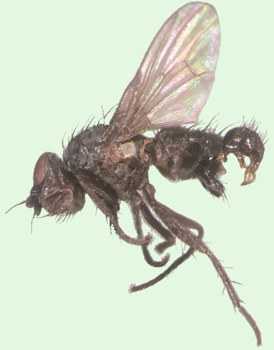Pests
Phorbia fumigata Meigen - Spring Fly.
Systematic position.
Class Insecta, order Diptera, family Anthomyiidae, genus Phorbia.Synonyms.
Phorbia securis Tiensuu, Phorbia tritici Rubtzov.Biological group.
Cereal pests.Morphology and biology.
The fly is 3.4-6 mm in length, coal-black with gray or brown wings with various hue. Imago has a strong ptilinum helping the fly to go out on a surface from depth down to 25 cm. Last abdominal segment of male is clavate; inner margin of V sternite covered regularly with thin setae. Dark longitudinal stripes on female thorax are absent or indistinct. Females (of spring generation) lay eggs inside sheath or palea of coleoptile. Sometimes the eggs are also found on outer side of paled and on leaves (these eggs usually do not develop and dry up). Eggs develop in 3 to 7 days. Larva is a cylindrical shape, white color, to 8 mm in length; 18-20 respiratory operculums on anterior respiratory appendages. Hind spiracles located on projections. Larvae move along central leaf to tillering node, making 2 to 4 spiral coils, eating away ear rudiment, and base of central leaf. The leaf fades, darkens, wilts, then gradually turns yellow and dries up, and the shoot perishes. Larva, as a rule, develop in only one shoot; rarely damages two. Larval stage lasts 25-30 days. Pupation occurs in ground at the end of May - the beginning of June (depending on weather conditions). Some puparia diapause until the next spring; others generate imagoes at the end of August - September, which lay eggs on shoots of winter wheat (autumn generation). Puparia varies in coloring (from straw-colored to red-brown) and body length (from 2 to 5.5 mm). The pest overwinters in puparia in ground at a depth of 2-3 cm or in stalks of winter cereals.Distribution.
Species is known in many countries of Europe from Great Britain to Spain and Poland; occurs in Hungary, Romania, Bulgaria, in all countries of Scandinavia, in the Baltic countries, in Byelorussia, Ukraine, Moldova, Georgia. In Russia the Spring Fly has been reported in the Leningrad and Rostov Regions, the Krasnodar and Stavropol Territories, the Volga Basin region, the Volgograd and Voronezh Regions. It is also known in the cismontane Urals, and in western and eastern Siberia. Further research is needed to determine distribution in yet unexplored lands.Ecology.
Monovoltine in the middle of the European part of FSU and Siberia, bivoltine (spring and summer generations) in the South. The beginning of imago flight comes in spring when average daily air temperature are 6-8°C and soil surface warms to 9-10°C. The flight lasts 30 to 40 days. Physiological synchronism in the development of the insect and fodder plant is the limiting factor of pest harmfulness. Precipitation in August and in the beginning of September play an essential role in reactivation of pupae after diapause.Economic significance.
The larvae cause the greatest damage to winter and spring wheat; they propagate also on rye, triticale, barley, varieties of Bromus sp. and timothy-grass (Phleum sp.). Species does not damage oat. Control measures include shelling of stubble after harvesting with subsequent autumn plowing, seed dressing prior to planting.Reference citations:
Belyaev I.M. 1974. Pests of grain crops. Moscow: Kolos. 284 pp. (In Russian)El'berg K.Yu. 1981. Antomyiidae. In: Narchuk E.P. & V.A. Tryapitsyn, eds. Insects and mites-pests of agricultural plants. Hymenoptera and Diptera. Leningrad: Nauka. V. 4: 188-198. (In Russian)
Makhotkin A.G., Pavlyushin V.A. 2001. Monitoring and control of Phorbia spp. on winter wheat. St. Petersburg: VIZR. 36 pp. (In Russian)
Makhotkin A.G., Pavlyushin V.A. 2003. Flies of the genus Phorbia in Azov-Black-Sea steppe. St. Petersburg: VIZR. 170 pp. (In Russian)
Rogochaya E.G. 1974. Antomyiidae. In: Vasil'ev, V.P., ed. Pests of agricultural crops and forest plantations. V.2. Kiev: Urozhai. 540-548 pp. (In Russian)


